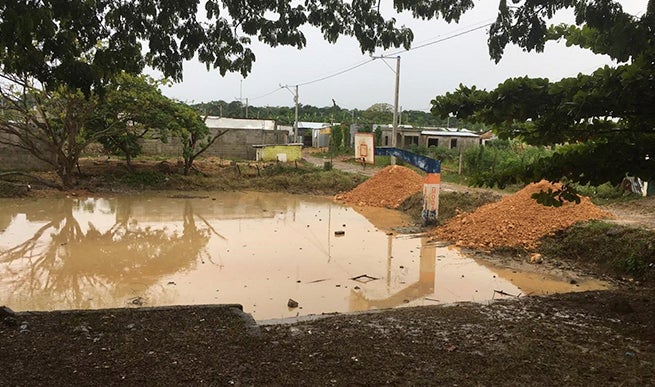
Edison Soto is an RMEI malaria specialist in the Inter American Development Bank.
La Ciénaga. That is the name of the Santo Domingo (Dominican Republic) neighborhood where the malaria parasite will pay the heaviest price for its defeat. There, in an area that was previously green and wet, over 17,000 people have lived for over four years, and in precarious conditions, divided into three sectors. Most of them are young migrants from rural zones or coming from the border with Haiti, who have travelled to Santo Domingo with the hope of finding a better future. However, the conditions of the environment they live in has made them prone to the disease.
Over 300 cases of malaria were accounted for in 2018 in La Ciénaga, representing over 60% of the total of recorded cases in the country. High temperatures; constant rain; humidity; dwellings with incomplete walls and streets without sewers; the lack of an urban vision in a floodable and swampy terrain; the absence of public transportation to the health center, are conditions that favor the proliferation of the disease vector mosquito and facilitate transmission. Even a basketball court built at the neighborhood school became, at the time, a vector breeding site, given that the works were carried out a few meters below the groundwater level and the rains keep it permanently flooded. Zone residents baptized the basketball court as the “malaria lagoon”.
An intersectoral army to fight the battle
However, since late 2018, malaria might have its days counted, not only in La Ciénaga and the Dominican Republic, but also in Panama, Costa Rica, Honduras, El Salvador, Nicaragua, Guatemala, Belize, Colombia and Mexico. A partnership between public and private partners has set out to fight the disease, case by case and house by house. The goal is to reduce to a minimum the presence of the parasite in foci such as La Ciénaga by 2020. This partnership, known as the Regional Malaria Elimination Initiative (RMEI), is made up by the national Governments, the Inter-American Development Bank (IDB), the Pan American Health Organization (PAHO), COMISCA, the Clinton Health Access Initiative (CHAI) and the Salud Mesoamerica Initiative.
Project funding, totaling over 102 million Dollars, is provided by private partners and national governments. The Bill & Melinda Gates Foundation, the Carlos Slim Foundation and The Global Fund to Fight AIDS, Tuberculosis and Malaria, have committed 52.5 million Dollars, while another 50 million come from national funds.
The battle continues…
The fight against malaria in La Ciénaga has already begun. And it has been done in all fronts. A team with public personnel and infrastructure has drained the “malaria lagoon” so that it may once again become a basketball court. Authorities have ensured that migrants with irregular status will not face legal problems if they go to a hospital if they have been bitten. Mosquito nets have been distributed to ensure the individual protection of the inhabitants, avoiding contact with the vector. Work is being carried out to improve Access to health services. And, most importantly, recruitment and training of an “army” of volunteers and professionals exclusively devoted to identifying and following, one by one, malaria cases in La Ciénaga has already begun.
The Dominican Republic health authorities, with the support of the RMEI team, have already identified the most influential local leaders with the purpose of building a community platform for detecting, diagnosing and treating all malaria cases. The goal is that this network detects every case of people with fever in La Ciénaga and, in less than 48 hours, a quick diagnosis and adequate treatment are provided. With this strategy, the transmission focus would be neutralized. Although the premise is simple, this is work that has to be performed block by block and house by house.
… at the regional level
The situation in La Ciénaga is not an exception. Almost all affected countries have similar experiences in the fight against malaria. But this Santo Domingo neighborhood is a perfect example of the complexity of the challenge. It is an urban sector, where the vector, people and parasites imported by infected humans living together led to an epidemic outbreak.
The big lesson it leaves in order to defeat malaria is that it has to be approached in an interdisciplinary manner. The health sector may mainly take care of facilitating access by the population to timely diagnosis and treatment. But other administrative sectors are also responsible, mainly civil society agents, such as community leaders, health promoters and the families themselves, who should assume a leading role in the defeat of this parasite.
The Dominican Republic and the rest of the countries of the region want to make history. They have assumed a generational challenge and the battle has begun. Malaria in Mesoamerica may have its days counted and its end has begun to be written in La Ciénaga.
What have efforts to eliminate malaria in your country been like? Tell us in the comments or mention @BIDgente in Twitter.